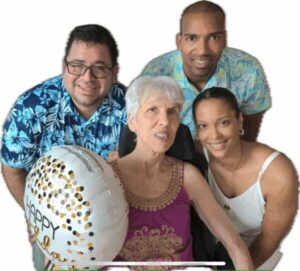For individuals and families who come to Help Hope Live for trusted medical fundraising, it can be difficult to help others understand just how easily a medical crisis can become a financial crisis.
This year, a feature documentary film gave millions of people the chance to step into the shoes of one unique individual and experience her journey with medical fundraising, mobility, advocacy, and independence.

Patrice: The Movie is an eye-opening 2024 documentary that explores the personal story of our Help Hope Live client Patrice Jetter and a universal fight for equality and independence across the disability community.
In this blog, we’ll tell you about Patrice, her partner Garry, the documentary Patrice: The Movie, and how Help Hope Live became a hopeful part of Patrice’s story.

Who Is Patrice Jetter?
60-year-old Patrice Jetter of Hamilton, New Jersey is many things, including an artist, an athlete, a loving partner, and a member of the disability community.
Patrice is living with diplegic cerebral palsy and multiple disabilities. She uses leg braces and walks with a crutch for mobility.
Patrice is dynamic, independent, and active. She loves sports like bowling, bocce, and figure skating. She lives independently in her apartment and works as a devoted crossing guard.

As Patrice explained in a WHYY interview, it took her more than a dozen applications to get the job—she overcame doubts that her diagnoses would get in the way of her job performance:
“They were really skeptical about hiring me to do the job. I turned out to be one of the best crossing guards they had.”
In her downtime, she’s a model railroad enthusiast and talented artist. She’s also a disability community advocate and a perpetual volunteer who helps kids in her community to learn to skate.
Who Is Garry Wickham?
“Garry is 20 minutes away, but it feels like we’re in a long-distance relationship.”
You can’t tell Patrice’s story without sharing her connection to Garry Wickham. Garry and Patrice are a couple who have been a part of each other’s lives for 35 years.
Garry is also living with disabilities, and though he lives just minutes away from Patrice, the two are unable to get married or cohabitate—not because they don’t want to, but because doing so could jeopardize the benefits they rely on to stay healthy and independent.

Why Can’t Patrice and Garry Get Married?
Garry and Patrice both rely on government benefits to survive, including to maintain affordable housing and medical care. Often, these benefits increase independence for someone with a disability, enabling care and services that otherwise would only be affordable while living in a nursing home or hospital.
To continue to qualify for these benefits, they must stay within a restrictive savings cap: neither can have more than $2,000 in the bank at a time. As Patrice explains:
“If I go $1 over that, I could lose my benefits. It’s a hamster wheel that keeps going round and round, and I can’t get off.”
While that cap already stands in the way of either Patrice or Garry meaningfully building up savings, safety, and financial independence, there’s another catch:
If Patrice and Garry get married, their combined savings cap will drop to just $3,000.
This “marriage penalty” was introduced decades ago, before the public or government’s view of the disability community included the idea that disabled people like Patrice and Garry would want what any other couple in love may want—to get married and live together.
The savings cap hasn’t changed since 1989. To account for inflation, in today’s dollars, the cap should approach $17,000 for a couple like Patrice and Garry.
Instead, they are stuck choosing between getting married or maintaining access to the benefits they rely on to survive while living with a disability. As Garry puts it:
“They punish you for feeling feelings like everybody else.”
What Is Patrice: The Movie About?
The barriers preventing Patrice and Garry from living together or getting married form one of the central topics in Patrice: The Movie, a documentary about Patrice’s life and fundraising efforts that came out in theaters and on Hulu in 2024.
Director Ted Passon met Patrice 20 years ago and knew he wanted to share her story and personality with the world.
The documentary has a uniquely imaginative and complex style. It takes viewers through both Patrice’s present life and key moments in her past, from growing up with a single mom to institutional living to finding her way to independence.
Throughout Patrice: The Movie, Patrice’s present is interspersed with formative highs and lows from her past re-enacted by children and young adults with disabilities alongside Patrice playing her younger self.
Patrice’s own artwork makes up the bright, colorful, and imaginative sets that bring these stories of her past to life.
Patrice: The Movie authentically shows intimate day-to-day moments with Patrice living, loving, advocating, reflecting, and fundraising.

Why Was Patrice Forced to Fundraise?
Fundraising is a central part of Patrice: The Movie.
Living on a highly limited part-time income and government benefits, Patrice has had to find her own ways to overcome barriers to independence and work.
She relies on an accessible van to get to her crossing guard job, but because a van is not covered by insurance, Patrice is frequently at the mercy of the unreliable used vans she can afford to keep getting to work and earning an income.
When these used vans break down, which they inevitably do, Patrice is left stranded until she can acquire another used van to keep her going.
Over time, Patrice’s friends encouraged her to start a GoFundMe to fundraise for a newer and more reliable van for daily use. Her community rallied and helped her fund that van—but instead of solving Patrice’s barriers to transportation, fundraising with GoFundMe put her at risk.
“I didn’t know GoFundMe counted as income against my benefits.”
Because funds raised through GoFundMe went into Patrice’s bank account, the government viewed these funds as income—even though she was fundraising for a medically related expense.
As a result, Patrice vastly exceeded her low $2,000 savings cap without even knowing it. She received letters indicating that she had lost her government benefits, including her state-funded housing and her Medicaid.
Instead of using funds raised through GoFundMe to purchase a van, Patrice was forced to immediately use them to cover emergency rent while she re-established her housing benefits.
She was transparent with her community at every step along the way, sharing with them how their generosity had inadvertently put her in a precarious position with her work and benefits.
With no accessible vehicle despite her successful fundraising efforts, Patrice lost her ability to get to work – and she had to resign from her much-loved position as a crossing guard.
After all the hard work Patrice and her community had put into fundraising, the loss of benefits was a massive emotional and financial setback.
Patrice is unique, but her story isn’t: it’s one we hear every single day at Help Hope Live. Members of the disability community are forced to fundraise to meet their basic needs and then penalized when they choose the wrong fundraising platform.
How Patrice Found Hope Through Help Hope Live
Patrice learned the hard way that GoFundMe posed a serious risk to her benefits and could no longer be a safe option for fundraising. That’s why she turned to Help Hope Live in 2022.
Unlike GoFundMe, Help Hope Live would administer the funds raised in Patrice’s honor and directly pay verified medical and related expenses. As a result, those funds wouldn’t overwhelm her savings cap or jeopardize her benefits.
Patrice had found a trustworthy medical fundraising platform in Help Hope Live—but she still had a lot of barriers to overcome. For members of the disability community who are forced to fundraise, fundraising can feel like having a demanding part-time job.
In Patrice: The Movie, viewers see Patrice navigate some of the physical and emotional challenges of fundraising. She sells artwork. She lugs bag after bag of Cans 4 a Van. In one scene, Patrice creates a video asking for donations in her honor. She has a bright smile on her face as she looks into the camera—but when it turns off, we see her break down into tears.

Needing to ask for help takes a visible toll on someone like Patrice who wants so ardently to be independent and spend her time helping others.
No one should be forced to fundraise, but Patrice: The Movie shows us the reality. Patrice has no choice but to ask for financial help from others just to continue living her life, going to work every day, and remaining independent.
Patrice’s community springs into action as they are presented with this urgent need. We see friends, loved ones, and advocates sharing her Help Hope Live Campaign Page and encouraging their networks to give whatever they can.
There is a sense of momentum and hope surging through that support network as the documentary goes on—but at the same time, we see Patrice, Garry, and their close friend Elizabeth wrestle with frustration and feelings of futility.
Again and again, Patrice fights through the mental barriers and recommits herself to action when faced with what feels like yet another overwhelming challenge.
Elizabeth asks Patrice, “How come you’re not just annoyed all the time?”
Patrice answers, “[Because] I have to do something.”
The documentary reaches a turning point when Patrice decides to check on her Help Hope Live Campaign Page to see if they’ve made any progress.
Dejected and feeling like her fundraising goal for a van is too far away to ever realistically reach, Patrice opens the page to find something unexpected: $55,000 raised in her honor.
“That’s got to be a mistake.”
Patrice can’t believe her eyes. She calls Help Hope Live to confirm that the total is an error.
She reaches Jen, a Client Services Coordinator, who checks with our Finance department. Jen replies to Patrice:
“That amount is accurate. It’s real. I’m so happy for you.”

Instantly, Patrice breaks down into overjoyed sobs. She is speechless. Beside her, Elizabeth and Garry’s eyes visibly shine with joy and hope. Patrice manages to say:
“We did it.”

Did Patrice Get a Happy Ending?
It’s an incredible and emotional moment when Patrice learns she’s exceeded her fundraising goal, and that moment just gets more powerful as the documentary moves forward and we get to see Patrice’s new, cherry-red accessible “dream car” pull up to her home.

There’s a reason why Patrice: The Movie doesn’t end on that moment.
Patrice met her fundraising goal and, with her community’s help, won her fight for safe transportation. However, for Patrice and the entire disability community, the real fight has not ended: the fight for marriage equality, financial independence, respect, recognition, reliable medical care, and basic human rights.
We watch Patrice, Elizabeth, Garry, and other disability advocates spearhead a ceremonial group marriage gathering where people in love pledge their commitment and advocate for marriage equality.
While the unions can’t be legally recognized without putting the couples in financial and medical jeopardy, as the participants look into each other’s eyes, the ceremony shows simply and as powerfully that members of the disability community feel and desire exactly the same things as everyone else.
It’s true that Patrice met her fundraising goal—but as Elizabeth explains, she never should have had to fundraise in the first place:
“Disabled people shouldn’t have to fundraise to get their needs met. It just means the system is broken.”
What Happened After Patrice: The Movie?
In the time since Patrice: The Movie began streaming on Hulu, Patrice has been interviewed countless times both locally and nationally.

Marriage equality has been explored outside the disability community with greater public awareness, amplified by mentions from celebrities like John Oliver (note: linked video includes explicit language).
The Social Security Administration issued an official statement in response to the documentary, pledging their willingness to work directly with Congress to increase savings caps and reform other outdated and restrictive elements of SSI benefits.
While advocating for national change, Patrice continues to fundraise with Help Hope Live to help offset lifelong medical expenses and related costs. Tax-deductible donations can be made at: https://helphopelive.org/campaign/20023/
Guestbook messages have poured into Patrice’s Campaign Page following the documentary’s release, praising her strength, resiliency, and advocacy.

At Help Hope Live, our team has received multiple fundraising campaign requests from individuals within the disability community who learned about our trusted medical fundraising from Patrice: The Movie.
Thanks to the documentary, these individuals now know that GoFundMe could jeopardize their benefits and put them at risk.
If you or someone you love is forced to fundraise, click here to learn how Help Hope Live could help create a financial lifeline through community fundraising backed by medical verification, one-on-one support, tax-deductible donations, and maximum protection for asset-based assistance.
Our 2024 Holiday Card – Artwork by Patrice
We are grateful to Patrice for creating original artwork for our 2024 Help Hope Live holiday card.
The central theme of the artwork is something that touches every scene of the documentary and Patrice’s lifelong fight for independence: hope.












